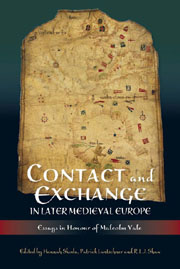Book contents
- Frontmatter
- Contents
- List of Illustrations
- List of Contributors
- Acknowledgements
- The Work of Malcolm Vale
- Principal Bibliography of Malcolm Vale
- Introduction
- Part I Boundaries and Units
- Introduction
- Economic Development, Social Space and Political Power in Bruges, c. 1127–1302
- Flemings in the Peasants' Revolt, 1381
- Does a Common Language Mean a Shared Allegiance? Language, Identity, Geography and their Links with Polities: The Cases of Gascony and Brittany
- Revisiting the Political Uses of Vernacular Language in Portugal during the Thirteenth Century: On Models, Motives and Modes
- Scotland in the Later Middle Ages: A Province or a Foreign Kingdom for the English?
- The Angevin Legacy, Dynastic Rivalry and the Aftermath of the Hundred Years War, 1453–1491
- Part II Practices of Exchange
- Conclusions
- Index
- Tabula Gratulatoria
Economic Development, Social Space and Political Power in Bruges, c. 1127–1302
from Part I - Boundaries and Units
Published online by Cambridge University Press: 05 February 2013
- Frontmatter
- Contents
- List of Illustrations
- List of Contributors
- Acknowledgements
- The Work of Malcolm Vale
- Principal Bibliography of Malcolm Vale
- Introduction
- Part I Boundaries and Units
- Introduction
- Economic Development, Social Space and Political Power in Bruges, c. 1127–1302
- Flemings in the Peasants' Revolt, 1381
- Does a Common Language Mean a Shared Allegiance? Language, Identity, Geography and their Links with Polities: The Cases of Gascony and Brittany
- Revisiting the Political Uses of Vernacular Language in Portugal during the Thirteenth Century: On Models, Motives and Modes
- Scotland in the Later Middle Ages: A Province or a Foreign Kingdom for the English?
- The Angevin Legacy, Dynastic Rivalry and the Aftermath of the Hundred Years War, 1453–1491
- Part II Practices of Exchange
- Conclusions
- Index
- Tabula Gratulatoria
Summary
In the county of Flanders, the emergence of medieval urban life is generally situated in the tenth century, the beginning of sustained growth in the late eleventh and the attainment of greatest demographic weight in the thirteenth century. As in other regions of north-western Europe, as a result of a commercial revolution and the extension and intensification of trade, the town developed as a distinct kind of social formation within feudal society. The merchant class played a fundamental role in shaping the social, institutional and topographical development of early medieval urban centres. In many parts of Europe, whether there had been continuity with Roman urbanisation or not, princely and seigneurial fortifications attracted merchants and artisans who usually settled on important river routes and formed a burgus or civitas. In his La production de l'espace, the French urban sociologist Henri Lefebvre called the medieval city a ‘space of accumulation’. Indeed, until c. 1300/1350, the Flemish towns and cities rapidly developed through a structural process of economic and demographic accumulation. Of course, the necessary condition for the growth of towns was rural development and accompanying population increase. Agricultural and demographic surpluses fed urban economic growth, quickening commerce and artisanal production, especially in regions where seigneurial power had diminished, and the movement of labour and spontaneous market development had become easier. This rise of the Flemish urban economy has become the historians' paradigm of strong and durable medieval economic growth. Since Henri Pirenne, many historians have focused on the rise of cities during the Middle Ages, often quoting Flemish examples.
- Type
- Chapter
- Information
- Contact and Exchange in Later Medieval EuropeEssays in Honour of Malcolm Vale, pp. 33 - 58Publisher: Boydell & BrewerPrint publication year: 2012



